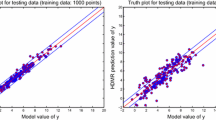Abstract
Multidimensional computer graphics are demonstrated in two medical systems applications in this paper. First, multidimensional computer graphics are utilized for descriptive purposes to show the differences among 10 physician specialty groups for multivariate data available at admission to medical school. Second, multidimensional computer graphics are demonstrated as a method that can be used for screening medical school applicants. The novel method utilized to represent multivariate data requires the plotting of a face. Each feature of a face—for example, face height or ear diameter—can be utilized to represent a different dimension of multivariate data, Each face then represents a vector whose elements are the mean values of multiple variables, or it represents a multivariate observation.
Similar content being viewed by others
References
Chernoff, H., The use of faces to represent points in k-dimensional space graphically.J. Amer. Stat. Assoc. 68:361–368, 1973.
Moriarity, S., Communicating financial information through multidimensional graphics.J. Acct. Res. 17:205–225, 1979.
Schwartz, L.E., and Cantwell, J.R., Weiskotten survey, class of 1960: A profile of physician location and specialty choice.J. Med. Educ. 51:534–540, 1976.
Weiskotten, J.G., Wiggins, W.S., Altenderfer, M.E., Gooch, M., and Tipner, A., Trends in medical practice: An analysis of the distribution and characteristics of medical school graduates, 1915–1950.J. Med. Educ. 5:1071–1121, 1960.
Jason, H., The admissions process in medicine.J. Med. Educ. 47:663, 1972.
Weisman, R.A., Weinberg, P.C., and Winstel, J.W., On achieving greater uniformity in admissions committee decisions.J. Med. Educ. 47:593–610, 1972.
Best, W.R., Diekema, A.J., Fisher, L.A., et al., Multivariate predictors in selecting medical students.J. Med. Educ. 46:42–50, 1971.
Best, W.R., Diekema, A.J., Fisher, L.A., Explorations in discriminant function analysis as an aid to admissions committees.J. Med. Educ. 42:276, 1967.
Milstein, R.M., Burrow, G.N., Wilkinson, L., et al., Prediction of screening decisions in a medical school admission process.J. Med. Educ. 51:626–633, 1976.
Cullen, T.J., The use of the discriminant function as a first screen of applicants to medical school. Office of Research in Medical Education, University of Washington, Seattle, Washington, 1975, (mimeo).
Watson, C.J., An empirical model of physician practice location decisions.Comput. Biomed. Res. 13:363–381, 1980.
Wingard, J.R., and Williamson, J.W., Grades as predictors of physician's performance.J. Med. Educ. 48:311–317, 1973.
Dube, W.F., and Johnson, D.G., Study of U.S. medical school applicants, 1974–75.J. Med. Educ. 51:877–896, 1976.
Kerlinger, F.N.,Foundations of Behavioral Research, Holt, Rinehart & Winston, New York, 1973.
U.S. Physician Reference Listing, 1975. Fisher-Stevens, Clifton, New Jersey, 1975.
Gough, H.G., Specialty preferences of physicians and medical students.J. Med. Educ. 50:581–588, 1975.
Bruckner, L.A., Johnson, M.D., and Tietjen, G.L., The analysis of lease, production and revenue data from offshore oil and gas leases.Proceedings of the Second ERDA Statistical Symposium, Oak Ridge, Tennessee, October 25–27, 1976.
Schmid, C.F.,Handbook of Graphic Presentation, Ronald Press, New York, 1954.
Chernoff, H., and Rizvi, M.H., Effect on classification error of random permutations of features in representing multivariate data by faces.J. Amer. Stat. Assoc. 70:548–554, 1975.
Author information
Authors and Affiliations
Rights and permissions
About this article
Cite this article
Watson, C.J., Watson, R.D. & Stephenson, N. Applications of multidimensional computer graphics in medical systems. J Med Syst 6, 171–181 (1982). https://doi.org/10.1007/BF00997051
Issue Date:
DOI: https://doi.org/10.1007/BF00997051




